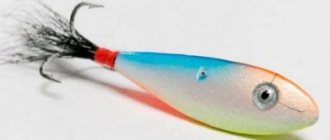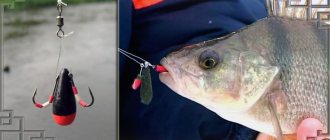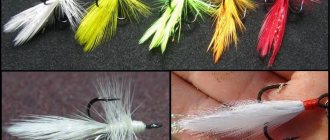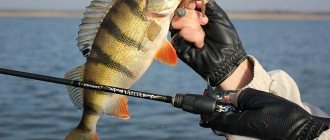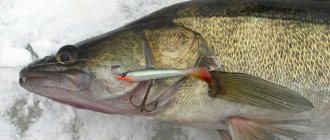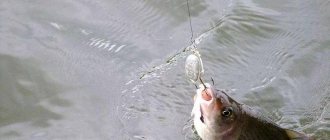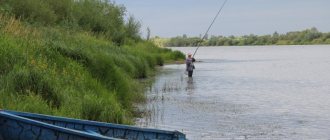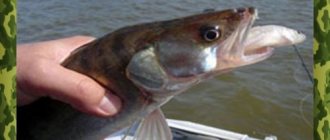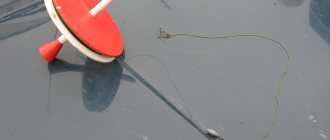catchable places
Despite the fact that this fish is found in almost all bodies of water that have clean water, sometimes it can be quite difficult to find its winter camps. The reason is that pike perch often changes them. Typical places are deep rocky and sandy slopes, holes littered with snags or driftwood, as well as other areas convenient for an ambush. On rivers, for example, on the Volga or Kama, in winter pike perch most often stays near bridge piles or breakwaters, near shallows.
Small or medium-sized fish prefer to gather in schools, while large specimens like to be alone. In general, catching this representative of perch involves not only catching gear for catching pike perch in winter, but also actively searching for the places where it lives. Often, beginners fish only the bottom layers. But this is a wrong approach. This fish is very sensitive to the amount of oxygen, therefore, even with a small influx of oxygen-saturated water, it tends to stick to the stream.
Tackle and rigging
In many ways, the result of fishing depends on proper preparation, namely gear. The fishing rod should have a whip (it doesn’t need to be too long, a medium one will suffice), a 70-90 mm reel, preferably a strong reel, as this is a fairly active fish. The fishing line must be appropriate - the optimal thickness is 0.35 mm. It is worth remembering that the fishing line for winter fishing must be coated with polymer resin.
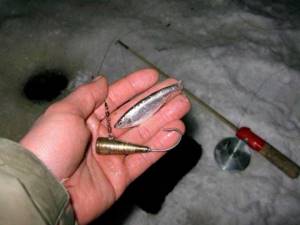
Use a snooker, a good way to arouse the interest of pike perch and burbot near the bottom
The correct equipment for winter sprat fishing:
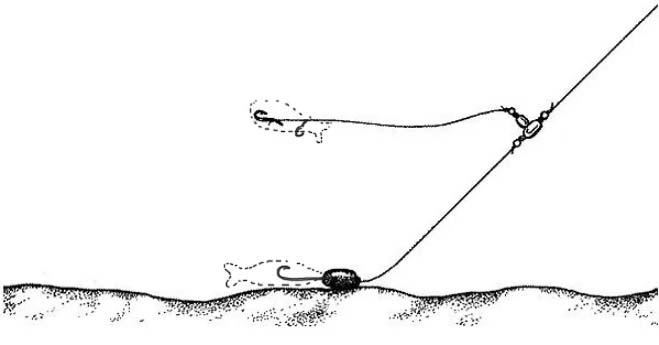
This is what a catchy tackle for pike perch with two sprat looks like (at the bottom there is a hook, at the top there are 2 hooks on a retractable leash). Fastened with a swivel.
The leash should be small - even 5 cm is enough. If you make it too short or, on the contrary, long, the fish will not swallow the bait, but will bite the line.

The sprat is impaled on the snitch
We also approach the choice of jigs responsibly - they should be marked, ideally with luminous paint - the fact is that pike perch, due to their nocturnal lifestyle, reacts perfectly to light in the dark.
You can also catch pike perch using a similar rig using girders. Use the guide for pike rigs, the only differences are in the installation that you see on this page.
The best improvement to the equipment would be to use a brighter knocker; there are a great many of them in stores. In general, by using exactly the installation that we recommend, you will already have gear with an enviable advantage over other anglers. Because often the use of a swivel, 3 hooks and a knocker goes by the wayside. But in vain.
Season
In winter they begin to catch pike perch with the first frosts and first ice. It is at this time that the fish, still full of energy, actively moves in a school along the bottom in search of prey. The best season is considered to be approximately a month after the installation of the ice crust. By the way, anglers should not forget about the concept of “tired” holes. Therefore, if a hunter has already pulled out prey from some hole, and then there is no bite, then it would be more correct to let it “rest” for an hour. Only after this is it worth trying again.
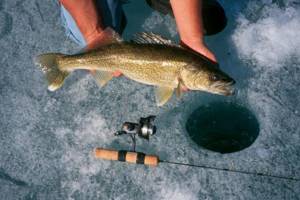
Gear requirements
To catch pike perch in winter, a fishing rod must be selected based on certain characteristics. This is the key to successful fishing. Such equipment for catching pike perch in winter, such as fishing rods, should be equipped with a comfortable handle and a reliable reel. It is important that the six is long and rigid for clear cutting. The fishing line should be taken with a thickness of 0.2 to 0.4 millimeters with an elongation of no more than two cm per meter. The choice of gear for catching pike perch in winter is selected depending on the design of the fishing rod and based on personal preferences. As for the leash, in this case, according to professionals, it is not needed.
Fishing on the feeder on the Kama (for a throw in the old way)
It might even be loudly called a regular spinning rod converted into a bottom tackle with the possibility of long-distance casting, even if it is a local version of the popular English tackle.
Take a spinning rod with a length of two to three meters, wind a fishing line with a cross-section of 0.4 mm, and attach a leash to it through a twist compensator, used for catching a predator.
A lead weight weighing from thirty to sixty grams is attached to the leash, plus two leashes of fishing line from 0.25 mm to the same 0.4 mm, hooks depending on the size of the expected trophy, by the way, the ruff is caught on any hook.
From one of the fishermen in the Perm region I heard the name of the ruffe - “King of the Kama”, when asked “why” he answered, “Because it bites.” And indeed, this “king” is not enough at the end of spring, beginning of summer, and then almost all summer and autumn.. And even if he doesn’t bite, then that day, most likely, will be without a catch.
Our feeder fishing began on paid ponds, where the main prey was carp. Although they also caught crucian carp, both with bottom tackle and with a float rod, carp was still more honorable. The maximum weight of the carp caught reached 5.2 kg.
The photo on the right shows a crucian carp caught in one of these ponds on a hot summer day. Middle of a day.
There is always enough for a person, and there are few “aquariums”, so we gradually moved to the Kama.
Fishing on the Kama
Newbies are lucky. Lucky indeed. A big river, a large species composition of fish, high hopes, no one knows who and what size you are dragging from the reservoir.
The spinning rods described above were used, all the gadgets like rocker arms, anti-twisters and even feeders were rejected for various reasons after a short practice of using them for one reason or another, the rocker arm was always spinning, no special effect was noticed from the feeders, over time they learned to make tackle so that special anti-twisters were Not needed. But the metal slingshots bought in the store turned out to be very convenient. Then the folding chairs were eventually replaced by women with folding chairs, plastic bags for small fishing items, and so on, and eventually the car trunk was completely loaded.
In the photo on the right is the bank of the Kama and our nooks and crannies.
First experience on the river
Flow is the main problem. You cast far, but everything gets carried closer to the shore, just downstream. It is convenient to fish near the confluence of some river with the Kama. When water masses flow into a river, a place appears where there is no current as such - continuous turbulence without a single direction of water movement.
If the feeder, then fishing from the shore is implied. Waiting for a bite, patience. This is a permanent event. Although the current and the ruffs don’t really allow you to relax. The current is so strong that it carries away a load of any weight and shape that can be cast with a spinning rod. In the spring, near the confluence of small rivers into the Kama, things are more fun, the fish apparently go to spawn.
Therefore, the choice of location is sometimes decisive. We have never fished in the spring at the confluence of a large river, for example the Belaya, into the Kama; the bite should be good there in the spring. But this is accessible from a boat, but during the spawning period it is not possible from a boat.
Fishing on a feeder
In the photo above, fishing is happening right at the confluence of a small river. If we get ahead a little, this cast turned out to be successful and brought a good bream. The gear in the spring has one hook, fishing is done with a worm. A wide variety of fish are caught, each creature has a pair. Based on the contents of the garden, you can write an article about the species composition of fish in the river.
The design itself is very simple: a lead sinker weighing 30-50 grams, a leash, which is used for catching predatory fish, and two hooks on leashes of fishing line with a thickness of 0.25 mm.
At the beginning of attaching the leash to the main line, a swivel is placed to prevent twisting.
All other attachments such as rocker arms, anti-twist, feeders and other things, in the presence of a current, gave nothing but unnecessary problems, although with the feeder this is a bit of a controversial issue.
The photographs show the gear in action, that is, with a catch.
Taking into account the occasional snags and, as a result, damage and sometimes even broken gear, we have an undeniable advantage in the simplicity, speed and low cost of creating a new one to replace the lost one.
The same tackle, if the type of bait is changed, in other words, if you plant fry, you can use it to catch predators, including pike perch. There have been cases of asp being caught using a worm. On the big river, which includes the Kama, you don’t know what you’ll get.
Source: https://fishing-fish.ru/2010-01-31-16-48-12/68-2010-01-31-16-38-37/2010-02-03-14-44-34/ 142-2010-02-03-14-48-34.html
Spoons
In winter, pike perch bites on baits of any shape or color. The main factors for successful fishing are four circumstances: when and where to use specific lures, and what shape and size to choose. To ensure a good catch in your arsenal you need to have both active baits and passive baits of various sizes. In this case, neither color nor decor play a significant role. Therefore, spinners are selected based on individual preferences. But the most important thing is that they must weigh more than four grams. This is the most important requirement for this equipment for catching pike perch in winter.
On the Volga
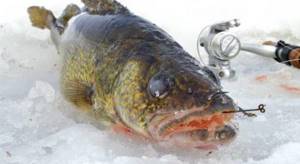
The success of ice fishing on this river primarily depends on the location. Typically, pike perch feeds in winter on underwater hillocks - the so-called navels, located at great depths with differences of four to five meters.
It is at such heights that this predator is caught. A balancer or spoon is used as bait. Catching pike perch on the ice on the Volga means searching for active fish, accompanied by constant drilling of holes. Having discovered the depth at which the predator stands, you can move along this level and fish quite large areas.
After the white fish leaves the shallow places on the river, the pike perch returns to its usual depths. In the dead of winter, when there is little oxygen in the water, it can fall into torpor. At this time, the fish, not feeding at all, may not bite at all on the Volga.
For pike perch on the Kama
Fishing on this river begins from the moment when the ice is already quite strong. It must be said that fishing on the Kama in winter is no less exciting than in summer. First, you need to find a suitable location. This is the most important condition for hunting success. Secondly, at this time of year this predator is quite “ascetic”: it eats quite sparingly. Therefore, you need to carefully choose gear for catching pike perch in winter on the Kama and bait that can tempt him.
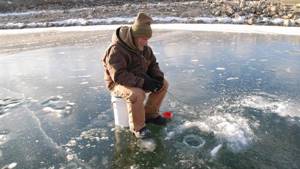
Under the first ice, this representative of perch bites well on a small spoon, reminiscent of a small fish. You need to attach a small piece of sponge to the hook. As for the gear, for catching pike perch in winter you can make the simplest fishing rod with your own hands, equipping it with a wire reel. It is better to use a rather hard whip for fishing on the Kama, from twenty to fifty centimeters in length. This choice is explained by the fact that during hooking the hook must dig deep into the mouth of the fish. The nod must be chosen to be elastic - such that it can withstand the weight of the spoon and not bend more than twenty-five degrees. It is with this equipment that the best winter pike perch fishing takes place on the Kama.
Fishing on kama in summer from a boat
Fishermen in the upper reaches of the Kama begin fishing for pike perch in open water somewhere in June, and this fishing period lasts until October, and in some cases until December. In most cases, fishing at this time is carried out using trolling.
But it should be noted that when fishing for pike perch on the Kama in this way, you will need an echo sounder so that the fisherman can determine the features of the bottom topography of the Kama, the depth of the river, in addition, this technical device all helps to determine the places where pike perch congregate on the Kama.
Already closer to the second half of the autumn period, fishermen on the Kama successfully catch trophy pike perch. Fishing for pike perch on the Kama shows good results at its mouth.
In winter, pike perch fishing on the Kama is carried out, in most cases, using a variety of pike perch spoons and balancers, jigs. In addition, fishermen often bet on pike perch on the Kama River.
In the spring, somewhere from the middle of the month of April to the end of the month of May, fishing for pike perch on the Kama is distinguished by the opportunity to catch very large individuals of this fish. It is worth noting the fact that on the Kama, spearfishing enthusiasts catch pike perch almost all year round.
What do you use to catch carp on a rock? Kama carp
- A.s. Pushkin wrote a fairy tale about a fisherman and a fish
- Aqua boats in Magnitogorsk
- Transported cargo on a boat trailer
- Bait table stonfo
But how to catch carp without using bait, you ask? The principle of fishing with such a device is designed specifically for carp, which, due to its natural habits, sucks on a large piece of food with its fleshy lips.
At this time, the hook, along with particles of soaked cake, enters the fish’s mouth. Naturally, the carp will try to spit it out, but getting rid of a bare hook in its mouth is almost impossible.
This is how self-cutting occurs. The carp bites on cake mainly from the second half of summer until the start of cold weather.
Most often, this method is used for night fishing. The lower reaches of the Amur River are considered a cult place for fishing for carp.
Why this particular river?
Catching carp in winter on the kama
The Amur has long been famous for its fish wealth, and wild carp lived there in incredible numbers. Fishing on the Amur for carp is also popular because it is here that you can catch a real trophy weighing up to 20 kg.
These places even host a fishing festival to catch it. Thousands of fishermen from all over the country come here every year to fish for wild carp.
Less commonly, carp enter narrow, remote parts of reservoirs, bays and backwaters, especially if the bottom is muddy. It should be borne in mind that it looks for areas with warmer water and loves the surf shore if the wind is western or southern.
The wind blows out small particles of food, the surface current carries them along the shore, and the wind also enriches the water with oxygen, which increases fish appetite, especially in summer. Catching carp from a boat In deep and fast areas, it is most comfortable to fish from a boat.
Usually it is installed on two anchors, one thrown from the bow, the other from the stern. When fishing from a boat, the feeder is secured near the stern or bow, usually placing the bait in gauze or mesh, through which the feed is slowly washed away.
You can also lower two feeders if there are two fishermen in the boat. The donka used in this case is quite simple.
It is installed on a spinning rod with a test of up to g or on a carp rod of a similar load. Many people use old-fashioned metal spinning rods to catch carp from a boat, which are very strong and make it easy to control hooked fish.
Its brake is sufficient to withstand the strongest currents when using thick monofilament.
For centuries, the Kama has been and remains, to this day, a great fishing river. Once upon a time, many tribes fed on the waters of the Kama, which abounded in numerous fish.
And although times have long changed and the waters of modern rivers are not as rich in fish as they once were, the Kama still attracts many fishermen today. And there are still a lot of fish there.
And if in the lower reaches of the Kama and its middle reaches there are fewer fish, then the upper reaches of the Kama are distinguished by fish abundance and diversity of species, and there it is quite possible to experiment with a variety of tackles and rigs.
Catching carp: How to catch carp with cake, with boilies and what gear is best for catching carp in the fall
Most of the fishermen who prefer to catch pike perch on the Kama use spinning rods to catch them. In addition, today this method of catching pike perch on the Kama is universal and the most cost-effective. They catch pike perch on the Kama with spinning rods, both from the shoreline and from boats.
For beginners, catching pike perch on the Kama using the jig method is more suitable. At the same time, fishermen use equipment such as Carolina or Texas, which bring success even to beginners in pike perch fishing.
The method of trolling for pike perch on the Kama River is also very popular; submersible wobblers are used, and fishing in the water column is very successful with this method.
In those parts of the Kama, with depths of three meters, in a calm current, fishermen are very successful in catching pike perch from boats using onboard fishing rods. In most cases, anglers use natural baits to catch pike perch on the Kama River, because pike perch is a predatory fish.
It is worth noting that fishermen on the Kama do not use girders so often, although this bottom tackle shows very good results in catching pike perch. .
Winter fishing for pike perch: Secrets of catching pike perch in winter
To make winter fishing for pike perch a success, you need to know some of the behavioral features of this predatory fish. When going winter fishing for pike perch, remember that pike perch prefer a hard sandy or gravel bottom.
Especially when it comes to winter fishing for pike perch. However, we should not forget that the location of river, lake or reservoir pike perch will have its differences.
I had to catch pike perch in winter in such reservoirs as Mozhaiskoye, Ruzskoye, Ozerninskoye, Rybinskoye and a number of others.
To make winter fishing for pike perch a success, you need to know some of the behavioral features of this predatory fish.
The Kama is the most important water artery of the western Urals. From ancient times until today, the river has been famous for its amazing fishing.
Significant depths, shallows, riffles with a jet current, which seduce many species of fish, cannot but attract beginners and experienced fishing masters. There is an opinion that fishing here is unearthly bliss.
Fishing brings a decent catch, but only for those who are rightfully considered professionals in the fishing business. And for this it is desirable to have some experience, knowledge of the basics of fish behavior and skills in basic fishing methods.
About 50 species of fish live in Kama, most of which are commercial.
Where to look for pike perch on the Kama River
Of course, before you start fishing for pike perch on the Kama River, you should know the most promising locations for pike perch on it. In this case, the preferences of the pike perch themselves should be taken into account, for example, the fact that the pike perch most of all prefers sections of the river that are more warmed up by the sun's rays, with clean water.
In addition, pike perch is caught well in those parts of the river where the bottom surfaces are the most difficult. In extreme heat, you should look for pike perch in the areas where streams and riffles are located on the river.
Source: https://ribaulov.ru/shimano/rybalka-kame-letom-lodki/
Tulka
DIY gear is quite common among ice fishing enthusiasts. No less important is bait, for example, sprat. Many people use either live or store-bought, usually frozen. It is important that the size of this fish does not exceed five centimeters, and its carcass is sufficiently elastic. This is necessary so that it does not fall apart on the hook of the tackle for catching pike perch. In winter, they catch a sprat in the following way: they hook it by the tail so that its head is facing the predator. No less acceptable is the method of fitting it in a semicircle. By and large, the freshness of the bait does not play a special role, the main thing is that it does not fall apart. In some regions, instead of sprat, another narrow-bodied fish, for example, bleak, is successfully used.
To the zherlitsa
Many people focus it primarily on pike. But in fact, this is an excellent type of tackle for catching pike perch. In winter, it is catchy enough from the ice to catch perch and even burbot. At the same time, no significant changes are envisaged in the design of the gear itself for catching predators. Zherlitsa is used to catch pike perch throughout the winter. Usually during freeze-up, this predator lives near the bottom, so it should be caught with deep live bait - gudgeon, perch or ruff.
It is better to install the zherlitsa in places where the bottom topography is variable, as well as near driftwood or snags. If the bite is bad, you need to start actively searching for prey, reinstalling the gear. Although this takes a lot of time, getting to the place where the flock is located will guarantee a successful catch.
Catching Pike-perch in Winter on Kama • ARTAFISH.RU
Pike perch. representative of the perch family. dreams of catching who the fisherman is. It reaches approximately seventy cm in length and weighs from 4 to 6 kilograms. An important role in the success of fishing is played by the competent choice of gear for catching pike perch in winter, especially in strong currents. At the same time, the search for this coveted prey. It's quite a troublesome matter.
Despite the fact that this fish is actually found in numerous reservoirs with unpolluted water, sometimes it is quite difficult to find its winter stops. The reason is that pike perch often changes them.
Common places are deep rocky and sandy dumps, holes littered with snags or driftwood, and other areas suitable for an ambush.
On rivers, for example, on the Volga or Kama, in winter, pike perch in most cases stays near bridge piles, or breakwaters, near the shallows.
Small or medium-sized fish prefer to gather in packs, while large specimens adore solitude. In general, catching this representative of perch fish.
not only catchy gear for catching pike perch in winter, but at the same time actively searching for the places where it lives. Often new fish fish only the bottom layers. Unfortunately this is the wrong approach.
This fish is very sensitive to the amount of oxygen, so even with a small influx of oxygen-saturated water, it tends to stick to the stream.
In winter they begin to catch pike perch with the first frosts and first ice. Now the fish, still full of energy, intensively moves in a school along the bottom in order to search for prey.
The best season is considered to be about a month after installing the ice crust. When, anglers should notice this concept as “tired” holes.
If the hunter has already taken the prey out of a certain hole, and there is no further bite, then it would be more correct to give it an hour to “rest”. Only then is it worth trying again.
To catch pike perch in winter, you need to select a fishing rod based on certain features. It is precisely this that is the key to successful fishing. Equipment for catching pike perch in winter, such as fishing rods, must be equipped with a comfortable handle and a reliable reel.
It is important that the six is long and rigid for clear cutting. The fishing line must be taken with a width of 0.3.5 to 0.4 mm with an elongation of less than 2 cm per meter. The choice of gear for catching pike perch in winter is selected based on the design of the fishing rod and considerations of personal preference.
As for the leash, then, according to the recommendations of experts, it is not needed.
In winter, pike perch bites on baits of any shape or color. The main factors for successful fishing are four things: when and where to use certain lures, and what shape and size to choose at the same time.
To ensure a good catch in your arsenal, it is necessary to have both active baits and passive baits of different sizes. In all this, neither color nor decor play a significant role. Therefore, lures are selected based on personal preferences. But also the most important thing.
it must weigh more than just 4 grams. This is the main requirement for this equipment for catching pike perch in winter.
The success of ice fishing on this river initially depends on the location. Usually pike perch feeds in winter on underwater hillocks. the so-called navels, located at enormous depths with differences from 4 to 5 meters.
It is at such heights that this predator is caught. A balancer or a spinner is used as bait. Fishing for pike perch on ice on the Volga. This is a search for active fish, accompanied by constant drilling of holes. Having found the depth, the predator stands still, there is an option, moving along this level, to fish quite large areas.
When the snow-white fish leaves shallow places on the river, the pike perch returns to normal depths again. In the dead of winter, when there is less oxygen in the water, he can fall into stupor. At that time, the fish, not feeding at all, may not bite at all on the Volga.
Catching predators on the Kama in winter (pike perch, perch, pike)
Fishing on this river begins from the moment when the ice is already quite strong. I must say that in winter fishing on the Kama is no two or more interesting than in summer. That's it, you need to find a suitable place.
This is the main condition for successful hunting. Secondly, at that time of year this predator is quite “ascetic”: it feeds rather poorly.
Therefore, it is necessary to carefully choose gear for catching pike perch in winter on the Kama and the bait that will be able to seduce him.
Under the first ice, this representative of perch fishes perfectly on a small spoon, reminiscent of a small fish. You need to attach a small piece of lip to the hook. As for the gear, for catching pike perch in winter, you can make the best ordinary fishing rod yourself, equipping it with a wire reel.
It is better to use a whip for fishing on the Kama that is quite rigid, from 20 to fifty cm in length. This choice is explained by the fact that at the time of hooking, the hook must dig deep into the mouth of the fish. The nod must be chosen as elastic. so that it can withstand the weight of the spoon and not even bend by more than 25 degrees.
With such equipment, the best winter pike perch fishing takes place on the Kama.
Some people focus it mainly on pike. However, in reality this is a beautiful type of tackle for catching pike perch. In winter, it is quite catchable from the ice for catching perch and burbot.
In this case, no important changes are foreseen in the design of the gear itself for catching predators. Zherlitsa is used to catch pike perch throughout the winter.
Usually, during freeze-up, this predator lives near the bottom, so it should be caught with deep live bait. gudgeon, perch or ruff.
Fishing in winter. Kama Ustye. Zander. Bersh
It is better to install the zherlitsa in places where the bottom topography is variable, and also near driftwood, as it is also called snags. If the bite is not good, it is necessary to begin an active search for prey, reinstalling the gear. Although this takes a long period, getting to the destination where the pack is located will guarantee a successful catch.
It is clear that it is much more difficult to unravel and lay this tackle on the bottom from the ice than it was during summer fishing. That’s why some people try to do it at home in order to greatly improve their fishing by modeling the donka for themselves. This winter bottom tackle for catching pike perch requires two sinkers.
light, weighing less than eight grams and designed to bloom with the flow, and heavier. up to 30 g, used at the bottom of the reservoir. Both of these components of equipment are sliding, freely moving along the fishing line to the stops.
For the latter, lead pellets or carbines with zippers are used.
Usually three leashes are tied to the donkey: one. at the end of the donk, just below the sinker with the smallest weight, and the other two. forty and seventy centimeters above his limiter.
The tackle is installed on the ice surface on spacers, in most cases. on wire flyers. They are attached to a whip to prevent the massive pike perch from dragging it into the hole. The main detail of the nod. spiral spring.
attached to the holder using brackets. Its internal diameter is expected to be more than just 3 mm.
In most cases, fishermen use a nod made from a spring taken from an alarm clock or from mechanical wind-up toys. At the end of the nod, a ring is soldered through which the fishing line is passed.
The other end is aggressively attached to the whip. The elasticity of the nod can be adjusted by moving a rubber roller with a wire clamp along the whip. If the ring hits the ring with sharp bites, it causes the fish to hook itself.
You can assemble a homemade winter donka as a result of fishing either on a separate board or on a reel located on the handle of the fishing rod. Experienced fishermen unhook the tackle from the main line, but only if they use a carabiner with a clasp as a limiter for the heavy sinker.
Source
Source: https://artafish.ru/lovlja-sudaka-zimoj-na-kame/
Homemade winter donka for pike perch
It is known that it is much more difficult to unravel and lay this tackle on the bottom from the ice than during summer fishing. Therefore, many try to do it with their own hands in order to optimize fishing as much as possible, modeling the donka for themselves. This winter bottom tackle for catching pike perch should have two sinkers - a light one, weighing no more than eight grams and intended for dispersing with the current, and a heavier one - up to 30 g, used at the bottom of the reservoir. Both of these components of equipment must be sliding, freely moving along the fishing line to the stops. Lead pellets or carabiners with fasteners can be used as the latter.
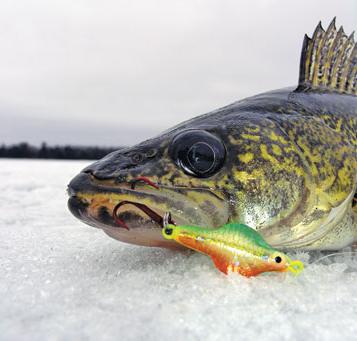
Usually three leashes are tied to the donkey: one is at the end of the donkey, just below the sinker with less weight, and the other two are forty and seventy centimeters above its limiter. The tackle is installed on the ice on spacers, most often on wire flyers. They are attached to a whip to prevent the powerful pike perch from dragging it into the hole. The main part of the nod - a spiral spring - is attached to the holder using brackets. Its internal diameter must be more than three millimeters.
Most often, anglers use a nod made from a spring pulled from an alarm clock or from mechanical wind-up toys. At the end of the nod, a ring is soldered through which the fishing line is passed.
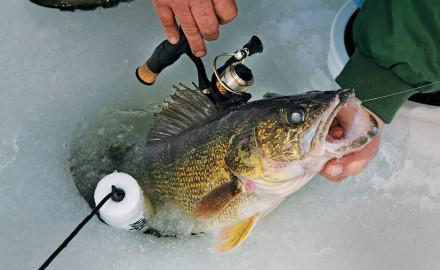
The other end is rigidly attached to the whip. The elasticity of the nod can be adjusted by moving a rubber roller with a wire clamp along the whip. In case of sharp bites, the ring, hitting the ring, leads to the fish hooking itself.
You can assemble a homemade winter donka after fishing either on a separate board or on a reel located on the handle of the fishing rod. Experienced fishermen unhook the tackle from the main line, but only if they use a carabiner with a clasp as a limiter for a heavy sinker.
Do-it-yourself tackle for catching pike perch in winter
Every angler dreams of catching pike perch, a member of the perch family. On average, it reaches a length of up to seventy centimeters and weighs from four to six kilograms. An important role in the success of fishing is played by the competent choice of gear for catching pike perch in winter, especially in strong currents. Moreover, the search for this desired prey is quite a troublesome task.
catchable places
Despite the fact that this fish is found in almost all bodies of water that have clean water, sometimes it can be quite difficult to find its winter camps. The reason is that pike perch often changes them.
Typical places are deep rocky and sandy slopes, holes littered with snags or driftwood, as well as other areas convenient for an ambush.
On rivers, for example, on the Volga or Kama, in winter pike perch most often stays near bridge piles or breakwaters, near shallows.
Small or medium-sized fish prefer to gather in schools, while large specimens like to be alone.
In general, catching this representative of perch involves not only catching gear for catching pike perch in winter, but also actively searching for the places where it lives. Often, beginners fish only the bottom layers. But this is a wrong approach.
This fish is very sensitive to the amount of oxygen, therefore, even with a small influx of oxygen-saturated water, it tends to stick to the stream.
In winter they begin to catch pike perch with the first frosts and first ice. It is at this time that the fish, still full of energy, actively moves in a school along the bottom in search of prey.
The best season is considered to be approximately a month after the installation of the ice crust. By the way, anglers should not forget about the concept of “tired” holes.
Therefore, if a hunter has already pulled out prey from some hole, and then there is no bite, then it would be more correct to let it “rest” for an hour. Only after this is it worth trying again.
Gear requirements
To catch pike perch in winter, a fishing rod must be selected based on certain characteristics. This is the key to successful fishing. Such equipment for catching pike perch in winter, such as fishing rods, should be equipped with a comfortable handle and a reliable reel.
It is important that the six is long and rigid for clear cutting. The fishing line should be taken with a thickness of 0.2 to 0.4 millimeters with an elongation of no more than two cm per meter. The choice of gear for catching pike perch in winter is selected depending on the design of the fishing rod and based on personal preferences.
As for the leash, in this case, according to professionals, it is not needed.
In winter, pike perch bites on baits of any shape or color. The main factors for successful fishing are four circumstances: when and where to use specific lures, and what shape and size to choose.
To ensure a good catch in your arsenal you need to have both active baits and passive baits of various sizes. In this case, neither color nor decor play a significant role. Therefore, spinners are selected based on individual preferences.
But the most important thing is that they must weigh more than four grams. This is the most important requirement for this equipment for catching pike perch in winter.
On the Volga
The success of ice fishing on this river primarily depends on the location. Typically, pike perch feeds in winter on underwater hillocks - the so-called navels, located at great depths with differences of four to five meters.
It is at such heights that this predator is caught. A balancer or spoon is used as bait. Catching pike perch on the ice on the Volga means searching for active fish, accompanied by constant drilling of holes. Having discovered the depth at which the predator stands, you can move along this level and fish quite large areas.
After the white fish leaves the shallow places on the river, the pike perch returns to its usual depths. In the dead of winter, when there is little oxygen in the water, it can fall into torpor. At this time, the fish, not feeding at all, may not bite at all on the Volga.
For pike perch on the Kama
Fishing on this river begins from the moment when the ice is already quite strong. It must be said that fishing on the Kama in winter is no less exciting than in summer. First, you need to find a suitable location.
This is the most important condition for hunting success. Secondly, at this time of year this predator is quite “ascetic”: it eats quite sparingly.
Therefore, you need to carefully choose gear for catching pike perch in winter on the Kama and bait that can tempt him.
Under the first ice, this representative of perch bites well on a small spoon, reminiscent of a small fish. You need to attach a small piece of sponge to the hook. As for the gear, for catching pike perch in winter you can make the simplest fishing rod with your own hands, equipping it with a wire reel.
It is better to use a rather hard whip for fishing on the Kama, from twenty to fifty centimeters in length. This choice is explained by the fact that during hooking the hook must dig deep into the mouth of the fish. The nod must be chosen to be elastic - such that it can withstand the weight of the spoon and not bend more than twenty-five degrees.
It is with this equipment that the best winter pike perch fishing takes place on the Kama.
Tulka
DIY gear is quite common among ice fishing enthusiasts. No less important is bait, for example, sprat. Many people use either live or store-bought, usually frozen. It is important that the size of this fish does not exceed five centimeters, and its carcass is sufficiently elastic.
This is necessary so that it does not fall apart on the hook of the tackle for catching pike perch. In winter, they catch a sprat in the following way: they hook it by the tail so that its head is facing the predator. No less acceptable is the method of fitting it in a semicircle. By and large, the freshness of the bait does not play a special role, the main thing is that it does not fall apart.
In some regions, instead of sprat, another narrow-bodied fish, for example, bleak, is successfully used.
To the zherlitsa
Many people focus it primarily on pike. But in fact, this is an excellent type of tackle for catching pike perch. In winter, it is catchy enough from the ice to catch perch and even burbot.
At the same time, no significant changes are envisaged in the design of the gear itself for catching predators. Zherlitsa is used to catch pike perch throughout the winter.
Usually, during freeze-up, this predator lives near the bottom, so it should be caught with deep live bait - gudgeon, perch or ruff.
It is better to install the zherlitsa in places where the bottom topography is variable, as well as near driftwood or snags. If the bite is bad, you need to start actively searching for prey, reinstalling the gear. Although this takes a lot of time, getting to the place where the flock is located will guarantee a successful catch.
Homemade winter donka for pike perch
It is known that it is much more difficult to unravel and lay this tackle on the bottom from the ice than during summer fishing. Therefore, many try to do it with their own hands in order to optimize fishing as much as possible, modeling the donka for themselves.
This winter bottom tackle for catching pike perch should have two sinkers - a light one, weighing no more than eight grams and intended for dispersing with the current, and a heavier one - up to 30 g, used at the bottom of the reservoir.
Both of these components of equipment must be sliding, freely moving along the fishing line to the stops. Lead pellets or carabiners with fasteners can be used as the latter.
Usually three leashes are tied to the donkey: one is at the end of the donkey, just below the sinker with less weight, and the other two are forty and seventy centimeters above its limiter.
The tackle is installed on the ice on spacers, most often on wire flyers. They are attached to a whip to prevent the powerful pike perch from dragging it into the hole. the nod part - a spiral spring - is attached to the holder using brackets.
Its internal diameter must be more than three millimeters.
Most often, anglers use a nod made from a spring pulled from an alarm clock or from mechanical wind-up toys. At the end of the nod, a ring is soldered through which the fishing line is passed.
The other end is rigidly attached to the whip. The elasticity of the nod can be adjusted by moving a rubber roller with a wire clamp along the whip. In case of sharp bites, the ring, hitting the ring, leads to the fish hooking itself.
You can assemble a homemade winter donka after fishing either on a separate board or on a reel located on the handle of the fishing rod. Experienced fishermen unhook the tackle from the main line, but only if they use a carabiner with a clasp as a limiter for a heavy sinker.
Source: https://FB.ru/article/189826/snasti-dlya-lovli-sudaka-zimoy-svoimi-rukami

